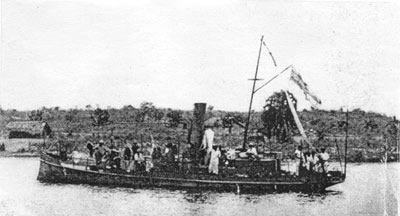|
After World War I Germany lost all its
colonies, including the most important one, South-West Africa. Austria, however,
gained a colony, namely German West Hungary. This was concluded during the peace
negotiations in St. Germain, after state chancellor Dr. Renner found the newly
created Republic of Austria became a bit too small.
“So we will borrow some land from the Hungarians!” he said half-jokingly in
his Viennese dialect. As this sentence had been recorded, the area in question
was initially named “Ausburgenland” (ausborgen = borrow), that later was
shortened to “Burgenland”.
 In 1921 Austria started to take possession of its newly acquired colony German
West Hungary (“Burgenland”). While the north of the country was sufficiently
developed, the south was widely white spots on the map. To remedy this
circumstance the Austrian Government entrusted the Scottish nobleman Sir Robert
Malcolm McDouglas Davy, who had already done great work in British colonies,
with the command of a gunboat which was to run down the river Lafnitz starting
in Styria.
In 1921 Austria started to take possession of its newly acquired colony German
West Hungary (“Burgenland”). While the north of the country was sufficiently
developed, the south was widely white spots on the map. To remedy this
circumstance the Austrian Government entrusted the Scottish nobleman Sir Robert
Malcolm McDouglas Davy, who had already done great work in British colonies,
with the command of a gunboat which was to run down the river Lafnitz starting
in Styria.
According to his diaries Sir Robert assumed the Lafnitz would lead southeast of
the Danube into the Black Sea or the Gulf of Corinth. So he was surprised when
he discovered after a short distance that the river led into another, larger
river. Davy intended to name this river after the Austrian Chancellor, Renner,
but wrongly named it Raab. But even with this mistake Sir Robert showed quite
amazing foresight, because engineer Julius Raab, then architect in St. Pölten,
should actually once become Chancellor of the Republic of Austria, however, much
later, after the Second World War ... |

